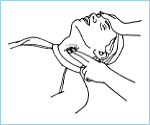Adult, child, and infant CPR & AED Course
Learn CPR. For Life™



ADULT BASIC LIFE SUPPORT (BLS)
Definition:
American Heart Association’s guidelines dictate that adult CPR is performed on any person over the age of 8 years old, or post-adolescence, as defined by the presence of secondary sex characteristics (i.e. puberty such as chest or underarm hair in males and any breast development in females).
SINGLE RESCUER ADULT BLS
- verify that the scene is safe for you and the victim
- check for responsiveness. Tap the victim’s shoulder and shout “are you ok”
- if the victim is not responsive, call for nearby help
- activate the Emergency Response System (for example, call 911 or mobilize Advanced Life Support team)
- retrieve the AED and emergency equipment, or send someone else if available
Scan the victim’s chest for rise and fall for no more than 10 seconds. If he’s not breathing normally he may be experiencing cardiac arrest.
Check pulse by palpating a carotid pulse. If pulse is not detected within 10 seconds, begin CPR.
Locating the carotid pulse:
- locate the trachea using 2 or 3 fingers

- slide fingers into the groove between the trachea and the muscles at the side of the neck, where you can feel the carotid pulse
- feel the pulse for no less than 5 but no more than 10 seconds. If you do not definitely feel a pulse begin CPR
If the victim is not breathing normally but a pulse is present, provide rescue breathing.
“Rescue breathing” is giving assisted breaths to an unresponsive victim who has a pulse but is not breathing. This can be done safely with a barrier device or bag-mask, or mouth to mouth if none available. Rescue breaths for adults are given at a rate of 1 breath every 5-6 seconds (about 10-12 breaths per minute)
- give each breath in 1 second
- each breath should result in visible chest rise
- check the pulse about every 2 minutes
Confirm that the ERS has been activated and continue rescue breathing. Check pulse about every 2 minutes and be ready to perform CPR. If opioid use is suspected, consider administering naloxone, if available.
If the victim is not breathing and has no pulse, begin CPR immediately.